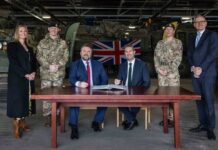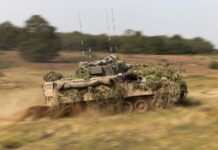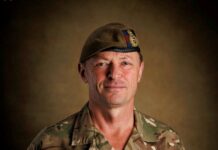A British Army team has successfully tracked, targeted and defeated swarms of drones in the latest trial of a new UK-developed radio-frequency directed-energy weapon (RF DEW), the UK Ministry of Defence (MoD) announced on 17 April 2025.
The trial was recently completed at Air Defence Range Manorbier in West Wales and was the largest counter-drone swarm exercise the British Army has conducted to date.
During the trial soldiers from 106 Regiment Royal Artillery were able to take down two swarms of drones in a single engagement using an RF DEW demonstrator mounted on a MAN/RMMV HX60 truck, while more than 100 drones were immobilised using the weapon across all trials.
The project, known as Ealing, has been delivered by Team Hersa: a collaboration between the UK MoD’s Defence Equipment & Support organisation and the MoD’s Defence Science and Technology Laboratory (Dstl) to develop directed-energy weapons.
Developed by a Thales UK-led industry consortium, the RF DEW demonstrator has been designed to explore the potential of radio-frequency weapons for the UK armed forces. It uses high-frequency radio waves to disrupt or damage critical electronic components inside drones, causing them to crash or malfunction. The system currently has a range of up to 1 km and is effective against targets that cannot be jammed using electronic warfare techniques.
Given that the RF DEW demonstrator only incurs a minimal ‘cost per shot’, if developed into operational service it could provide a significantly more cost-effective counter-drone weapon when compared to traditional missile- or even gun-based air defence systems.
The UK government has invested more than GBP 40 million (EUR 46.7 million) in RF DEW research and development to date, according to the UK MoD.
The successful trial comes as drone swarms are being increasingly seen in use in frontline combat in Ukraine, with UK Defence Intelligence estimating that in 2024 Ukrainian forces had to defend against attacks from more than 18,000 drones (including bomb-laden unmanned aerial vehicles (UAV) and loitering munitions).
‘Sergeant Mayers’, a senior UAV operator from 106 Regiment Royal Artillery who during the RF DEW trial became the first British soldier to bring down drones using a radio-frequency weapon, was quoted by the MoD as saying, “RF DEW is an exciting concept. We found the demonstrator quick to learn and easy to use. With improvements on range and power, which could come with further development, this would be a great asset to layered air defence.”
Nigel MacVean, managing director of Thales Integrated Airspace-protection Systems, added, “Thales continues to be at the forefront of this pioneering technology, and we are proud to continue the research and development in this sector alongside our partners in government.”
The RF DEW trial followed another Team Hersa event in October 2024 in which the British Army conducted its first trial with a vehicle-mounted version of Raytheon UK’s High-Energy Laser Weapon System (HELWS) at the Radnor Range in Wales. In that trial, which used a HELWS mounted on a Wolfhound 6×6 protected patrol vehicle, soldiers from the army’s 16th Regiment Royal Artillery were able to successfully track and neutralise moving mini-UAVs.











